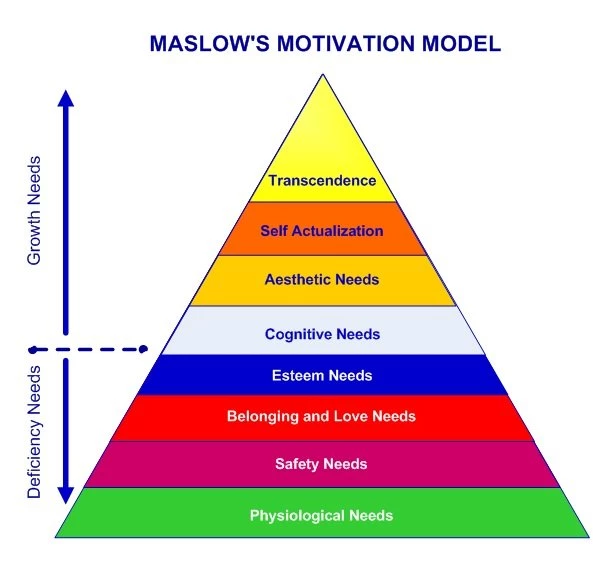At a time when most are wondering what the post-pandemic recovery would look like, a reasonable answer may be that no specific letter would provide a complete enough answer. Economies are made up of a large array of sectors and exiting the pandemic-induced crisis will have its sector-specific particularities that cannot be ignored. To identify them, we need to start with the weakest link which gave rise to the economic troubles: the human being. This means that future economic developments will be closely reliant on how fast human behavior changes, in particular on how people’s priorities/needs will shift in the upcoming period.
As far as priorities/needs are concerned, what better starting point is there other than Maslow’s model. The hierarchy of needs designed by the famous American psychologist forms the motivational model which is based on five tiers of needs, later supplemented, by the psychologist himself by three other dimensions mentioned within parenthesis: physiological, safety, love and belonging, (cognitive, aesthetic needs), esteem, self-actualization, (transcendence). Most likely, this hierarchy of needs may be the key to how various industries across the economy can recover.
The pyramid rests on the basic (physiological) human needs, such as food, clothes, shelter. We can safely estimate that suppliers of basic goods and services have had the least to suffer from the pandemic and talking about a recovery doesn’t make too much sense in their case. Demand has remained constant, although there has been variation in consumers’ preferences.
I am thinking, for instance, that as working from home was a predominantly white collar practice, the demand for ties, suits, shirts fell and that for casual clothes rose. Or the fact that the demand for homes cannot drop, but the demand structure is expected to change from office to residential spaces, from apartments to houses or from ownership to renting.
 Next, we have the need for safety. Because this area has suffered a severe blow during the pandemic, all products and services meant to boost it saw the demand skyrocket. The most obvious example are pharmaceuticals, medical devices and healthcare services. But it goes beyond that. Given that safety is ensured by distancing and lack of direct contact, all products and services designed to maintain the distance have also experienced a spike in demand: online stores, remote working apps, courier businesses.
Next, we have the need for safety. Because this area has suffered a severe blow during the pandemic, all products and services meant to boost it saw the demand skyrocket. The most obvious example are pharmaceuticals, medical devices and healthcare services. But it goes beyond that. Given that safety is ensured by distancing and lack of direct contact, all products and services designed to maintain the distance have also experienced a spike in demand: online stores, remote working apps, courier businesses.
Will a medical remedy completely upend the situation to see the demand for such services drop? I doubt it. Let us not forget the fact that we will continue to be more anxious than we were a year ago for a good amount of time going forward, that immunization cannot be done overnight, and its success is still uncertain. This is why I expect to see the demand for medical products and services remain probably unchanged for another year, and slightly drop afterwards.
For example, it is not realistic to expect the same level of demand for face masks, PPE or ventilators. Once the strategic stockpile is created, the demand for products and services specific to a reactive approach will decrease significantly, while that needed in a proactive approach will remain high (e.g. vaccines).
Being “coerced” into discovering the benefits of e-commerce will determine many to continue to shop online and e-trading is expected to maintain the level of sales it has reached so fast.
The next tier refers to the need for love and belonging which was the main cause of popular frustration. Social distancing was the opposite: being cut-off, with no social interaction of any kind. In such a setting, economic sectors that rely on human socialization and which bore the brunt of this crisis are most likely set to experience a mind-boggling rebound. I am now thinking about restaurants and pubs, parks and the businesses that provide them or the big sporting and cultural events. The replacements fall far short of satisfying this tier of needs which is why we should expect them to return to pre-pandemic levels.
I believe that the same applies to the cognitive and aesthetic needs which suffered greatly during this period. Again, there are not many replacements here and the ones that exist, are far from perfect. They will also see pre-pandemic levels of sharp growth in holidays abroad and related flights, good-quality cultural shows that we enjoy together, travel and general knowledge-driven activities.
Airlines, however, will continue to experience low levels of business travel, by far the most lucrative line. Although only 12% of all flight tickets sold, business travel contributed up to 75% to airline profitability. The fundamental shift in remote business communication brought about by the pandemic, is probably here to stay. This is why, the steep decrease in business trips will become the rule and eat a big chunk out of their profits.
The remainder of Maslow’s needs have little relevance relative to their economic impact.
It was not my goal to put together an exhaustive list of all industries which will recover, but rather to suggest an approach based on which stakeholders might assess how fast and how important the upcoming changes will be so as to be ready when the starter pistol is fired. So think of the needs fulfilled by your business and check their position on Maslow’s pyramid.



